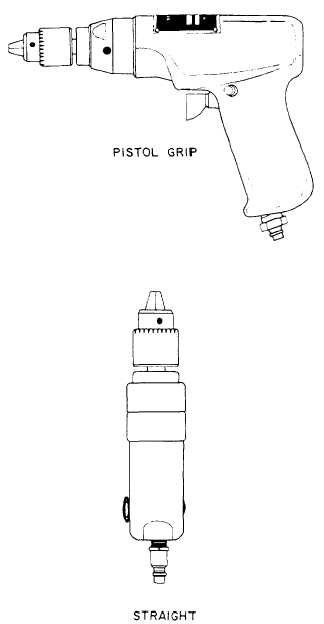ONE-SHOT GUN.—The one-shot gun is
designed to drive the rivet with just one blow. It is
larger and heavier than other types and is generally
used for heavy riveting.
Each time the trigger is
depressed, the gun strikes one blow. This gun is
rather difficult to control on light-gauge metals.
Under suitable conditions, it is the fastest method of
riveting.
SLOW-HITTING GUN.—The slow-hitting gun
has a speed of 2,500 bpm (blows per minute). As long
as the trigger is held down, the rivet set continues to
strike the rivet. This gun is widely used for driving
medium-sized rivets. It is easier to control than the
one-shot gun.
FAST-HITTING GUN.—The fast-hitting gun
strikes the rivet with a number of relatively
lightweight blows. It strikes between 2,500 and 5,000
bpm and is generally used with the softer rivets. Like
the slow-hitting gun, it continues to strike the rivet
head as long as the trigger is depressed.
CORNER RIVETER.—The corner riveter is so
named because it can be used in corners and in close
quarters where space is restricted. The main
difference between this riveter and the other types is
that the set is very short and can be used in confined
spaces. See figure 13-11.
SQUEEZE RIVETER.—The squeeze riveter
differs from the other riveters in that it forms the rivet
head by means of squeezing or compressing instead
of by distinct blows.
Once it is adjusted for a
particular type of work, it will form rivet heads of
greater uniformity than the riveting guns. It is made
both as a portable unit and as a stationary riveting
machine.
As a portable unit, it is larger than the
riveting guns and can be used only for certain types of
work that will fit between the jaws. The stationary, or
fixed jaw, contains the set and is placed against the
rivet head in driving. The rivet squeezer shown in
figure 13-11 is the pneumatic type.
DRILLS
As is commonly known, drills are used to bore
holes. In the following paragraphs, the correct use
and some common errors in the usage of drills are
presented.
Additionally, a brief description of
pneumatic and angle-drive drills is included.
Portable Drills
Before using a drill turn on the power and check
it for trueness and vibration. Do not use a drill bit that
wobbles or is slightly bent. Trueness may be visibly
checked by running the motor.
The most common error made by the inex-
perienced person is to hold a portable drill at an
incorrect angle to the work. Make sure the drill is
held at right angles to the work. When you are
drilling in a horizontal position, you can see if the drill
is too far to the right or left, but it is difficult to tell if
the rear of the drill is too high or too low. Until you
Figure 13-12.—Pneumatic drills.
13-8

